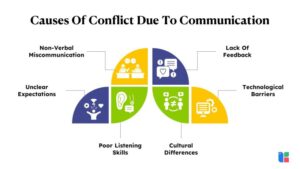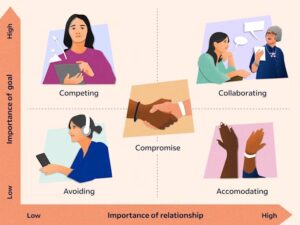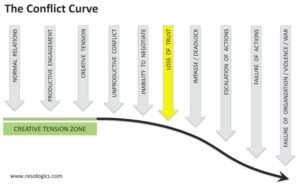Conflict Management in the Workplace: Strategies for a Healthy Work Environment
Conflict is considered as an inevitable part of any organisation and trait of any workspace. It may be exhibited in the form of differences in opinions, work and personality styles, communication barriers, or competing goals can lead to tension among colleagues. While conflict may seem negative, if handled effectively, it can lead to growth, innovation, and stronger teamwork. However, Conflict also serves as a basis of social interaction that only happens because of differences or a mismatch of conditions perceived and internalised by the employees. It is natural to have difference of opinion rather than difference in the cultural setup. Therefore, right strategies may help in minimising the effects of conflict and to have better work culture.
Common Causes of Workplace Conflict
- Communication Gaps: Misunderstandings, unclear instructions, or lack of communication often lead to confusion and frustration among the employees. For example: The deadlines and the limited time given to the team, last minute work, and lack of proper guidelines to complete the task.

- Diverse Work Styles: Differences in how people approach tasks, deadlines, and responsibilities can cause friction. For example: Managing the time appropriately may be a priority for some and may not be relevant to others.
- Competing Goals: When departments or individuals pursue objectives that conflict, tensions can rise like the team members competing with themselves in a negative way to prove themselves to complete the task. Individual objectives become more important than the company welfare.

- Personality Clashes: Incompatible personalities or values can create an uncomfortable working environment. For example: Very few people would understand the basic difference between assertiveness and rudeness with the team members.
- Power Struggles: Disputes over authority or decision-making often lead to conflicts between team members or departments. For example: Many a times, power imbalances would instigate the employees to have explicit conflict at work place.
Negative Impacts of Unresolved Conflict
Unresolved conflict in the workplace can severely impact employee well-being, productivity, and the overall organizational environment. It can lead to strained working relationships, decreased productivity, increased stress, and even legal issues and toxic culture, if left unaddressed. Addressing conflict early and effectively is crucial for maintaining a healthy and productive work environment. The conflict curve emphasizes on the fact that conflict should be resolved appropriately and suggestive measures should be taken at the right time, otherwise it may lead to loss of trust among the employees.

Strategies to Resolve Conflict at Workspace
Conflict can be minimized, if addressed properly and with constructive approach in the right time. There are various strategies but the below ones are tried and tested in the workplace. These may seem to be tiny but once developed as tiny little habits at the workplace, the toxic culture would not surface.
- Open and Honest Communication
Encourage a culture of transparent dialogue and interaction. For example, employees should feel safe to voice the concerns, inhibitions without the fear of retaliation.
- Active Listening
Listening is the most important skill that should be internalized without any barriers. One should listen without interruption or judgment. Most importantly, validating the feelings and responding constructively would help in mitigating the relationships.
- Address Issues Early
There are times that prolonging the issue, not addressing the issue may lead to grape vine communication in the workspace. Longer the conflict, more the damage to the organization.
- Focus on the Issue, Not the Person
Now the question is how to address the issue? By avoiding personal attacks, sarcasm, silent treatment, cornering the person and not addressing individually may lead to behavioral issues ‘subconsciously’. One should discuss the behavior or situation that caused the conflict in detailed manner with constructive approach.
- Seek Common Ground
Another strategy is to shift the focus from conflict to collaboration. One should identify the shared goals and values rather than the personal attack on someone.
- Use Mediation if Necessary
There are times, when complex situations would arise then one should involve the third party like HR professional or manager to help in resolving the conflict. This will ascertain fair resolution as well.
- Set Clear Expectations
All these strategies would be unmanageable if a well defined roles, responsibilities and expectations would not be communicated to the employees. Many a times, we can anticipate the conflicting situations before hand and set the expectations clearly.
- Provide Conflict Resolution Training
The employees can be given skill development workshops and training to develop their inter personal skills in a better manner.
Therefore, we cannot say that conflict can not be resolved rather the right mindset and tools, conflicts can be managed to build stronger relationships, encourage innovation, and create a more cohesive and productive work environment.





Leave a Reply